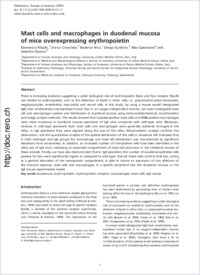Mast cells and macrophages in duodenal mucosa of mice overexpressing erythropoietin
- Ribatti, Domenico Department of Human Anatomy and Histology, University of Bari Medical School, Italy
- Crivellato, Enrico Department of Medical and Morphological Research, Section of Anatomy, University of Udine Medical School, Italy
- Nico, Beatrice Department of Human Anatomy and Histology, University of Bari Medical School, Italy
- Guidolin, Diego Department of Human Anatomy and Physiology, Section of Anatomy, University of Padua Medical School, Italy
- Gassmann, Max Institute of Veterinary Physiology, Vetsuisse Faculty and Zurich Center for Integrative Human Physiology, University of Zurich, Switzerland
- Djonov, Valentin Department of Medicine, Institute of Anatomy, University of Fribourg, Switzerland
-
18.08.2009
Published in:
- Journal of Anatomy. - 2009, vol. 215, no. 5, p. 548-554
English
There is increasing evidence suggesting a wider biological role of erythropoietin (Epo) and Epo receptor (EpoR) not related to erythropoiesis, such as the detection of EpoR in other cells, i.e. polymorphonuclear leukocytes, megakaryocytes, endothelial, myocardial and neural cells. In this study, by using a mouse model (designated tg6) that constitutively overexpresses human Epo in an oxygen-independent manner, we have investigated mast cell and macrophage number and distribution in duodenal mucosa using immunohistochemical, morphometric and image analysis methods. The results showed that tryptase-positive mast cells and BM8-positive macrophages were more numerous in duodenal mucosa specimens of tg6 mice compared with wild-type mice. Moreover, whereas in wild-type specimens both mast cells and macrophages were generally scattered throughout the villus, in tg6 specimens they were aligned along the axis of the villus. Morphometric analysis confirms this observation, and the quantitative analysis of the spatial distribution of the cells in duodenal villi indicated that in both wild-type and tg6 groups the macrophage and mast cell distribution was characterized by significant deviations from randomness. In addition, an increased number of c-kit-positive cells have been identified in the villus axis of tg6 mice, indicating an expanded compartment of mast cell precursors in the intestinal mucosa of these animals. Finally, we have also demonstrated that in tg6 specimens the number of duodenal epithelial cells positive for Epo were significantly higher as compared to wild type. Overall, these data confirm that Epo, acting as a general stimulator of the hemopoietic compartment, is able to induce an expansion of two effectors of the immune response, mast cells and macrophages, in a specific peripheral site, the duodenal mucosa, in the tg6 mouse experimental model.
- Faculty
- Faculté des sciences et de médecine
- Department
- Département de Médecine
- Language
-
- English
- Classification
- Biological sciences
- License
-
License undefined
- Identifiers
-
- RERO DOC 12640
- DOI 10.1111/j.1469-7580.2009.01131.x
- Persistent URL
- https://folia.unifr.ch/unifr/documents/301254
Statistics
Document views: 95
File downloads:
- pdf: 124
